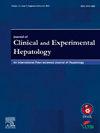Combined Living Donor Liver Transplantation With Coronary Artery Bypass Grafting: Possible but not Without a Struggle
IF 3.3
Q2 GASTROENTEROLOGY & HEPATOLOGY
Journal of Clinical and Experimental Hepatology
Pub Date : 2025-02-14
DOI:10.1016/j.jceh.2025.102515
引用次数: 0
Abstract
Background
A combined liver transplant (LT) and coronary artery bypass grafting (CABG) may sometimes be needed for patients with decompensated cirrhosis who also have significant coronary artery disease (CAD). However, such a procedure is associated with significant morbidity and mortality.
Methods
From May 2012 to August 2020, eight patients with significant coronary artery disease (CAD) underwent combined off pump CABG (OPCAB) and living donor liver transplantation (LDLT) at our center. We analyzed patient demographics, preoperative clinical findings, operative details, and postoperative outcomes.
Results
Mean recipient age and body mass index were 59 ± 6 years and 26 ± 3kg/m2, respectively. The model for end-stage liver disease (MELD) score was 20. Four patients each had hypertension and diabetes. Mean total duration of the surgery was 982 ± 117 min, with 598 ± 89 min for living donor liver transplantation (LDLT). The mean volume of packed red blood cell transfusion was 2500ml. The duration of the ventilatory support (median 49 h post-surgery), and the median intensive care unit and hospital stay (8 and 18 days, respectively). Two patients died during the postoperative period due to sepsis with multiorgan failure No recipient had evidence of acute coronary syndrome, stress cardiomyopathy; none required interventional hemodynamic support. Four patients developed atrial arrhythmia's in the post-operative period, all were managed successfully with medical management.
Conclusion
Combined CABG and LDLT is feasible but poses significant challenges. Careful preprocedure planning, and meticulous intra- and post-operative management involving a multidisciplinary team of LT Surgeons and anesthetists, hepatologists, cardiologists, and cardiac surgeons is required to ensure optimal outcomes in these patients.

活体肝移植联合冠状动脉旁路移植术:可能但并非没有斗争
背景:合并肝移植(LT)和冠状动脉旁路移植术(CABG)对于伴有严重冠状动脉疾病(CAD)的失代偿性肝硬化患者有时是必要的。然而,这种手术与显著的发病率和死亡率相关。方法2012年5月至2020年8月,8例严重冠心病(CAD)患者在我中心行联合停泵CABG (OPCAB)和活体供肝移植(LDLT)。我们分析了患者人口统计学、术前临床表现、手术细节和术后结果。结果患者平均年龄59±6岁,体重指数26±3kg/m2。终末期肝病模型(MELD)评分为20分。四名患者分别患有高血压和糖尿病。平均总手术时间为982±117 min,活体肝移植(LDLT)为598±89 min。平均输血量为2500ml。呼吸支持持续时间(术后49小时中位数),重症监护病房和住院时间中位数(分别为8天和18天)。术后2例患者因脓毒症合并多器官功能衰竭死亡,无急性冠状动脉综合征、应激性心肌病;没有人需要介入血流动力学支持。4例患者术后发生心房心律失常,均经药物治疗成功。结论冠脉搭桥与LDLT联合治疗是可行的,但存在较大的挑战。需要一个由LT外科医生、麻醉师、肝病学家、心脏病学家和心脏外科医生组成的多学科团队进行精心的术前计划和细致的术中及术后管理,以确保这些患者的最佳预后。
本文章由计算机程序翻译,如有差异,请以英文原文为准。
求助全文
约1分钟内获得全文
求助全文
来源期刊

Journal of Clinical and Experimental Hepatology
GASTROENTEROLOGY & HEPATOLOGY-
CiteScore
4.90
自引率
16.70%
发文量
537
审稿时长
64 days
 求助内容:
求助内容: 应助结果提醒方式:
应助结果提醒方式:


